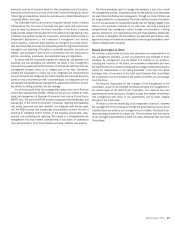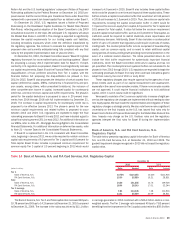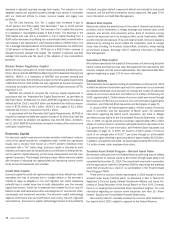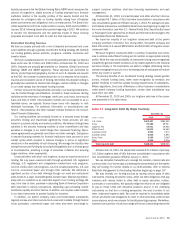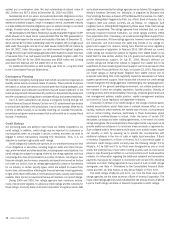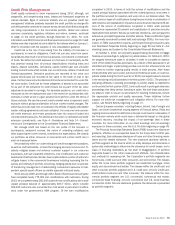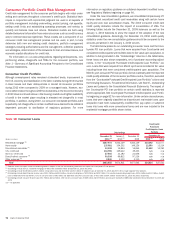Bank of America 2010 Annual Report Download - page 72
Download and view the complete annual report
Please find page 72 of the 2010 Bank of America annual report below. You can navigate through the pages in the report by either clicking on the pages listed below, or by using the keyword search tool below to find specific information within the annual report.decrease in adjusted quarterly average total assets. The reduction in risk-
weighted assets and adjusted quarterly average total assets is consistent
with our continued efforts to reduce non-core assets and legacy loan
portfolios.
The FIA Card Services, N.A. Tier 1 capital ratio increased 9 bps to
15.30 percent and Total capital ratio decreased 7 bps to 16.94 percent
compared to December 31, 2009. The increase in Tier 1 capital ratio was due
to a decrease in risk-weighted assets of $22.3 billion. The decrease in the
Total capital ratio was due to a reduction in Tier 2 capital resulting from a
$390 million decrease in qualifying term subordinated debt combined with a
net increase in the allowance for credit losses limitation of $269 million. The
Tier 1 leverage ratio decreased to 13.21 percent at December 31, 2010 from
23.09 percent at December 31, 2009 due to a $68.9 billion increase in
adjusted quarterly average total assets. The increase in adjusted quarterly
average total assets was the result of the adoption of new consolidation
guidance.
Broker/Dealer Regulatory Capital
Bank of America’s principal U.S. broker/dealer subsidiaries are Merrill Lynch,
Pierce, Fenner & Smith (MLPF&S) and Merrill Lynch Professional Clearing Corp
(MLPCC). MLPCC is a subsidiary of MLPF&S and provides clearing and
settlement services. Both entities are subject to the net capital requirements
of SEC Rule 15c3-1. Both entities are also registered as futures commission
merchants and subject to the Commodity Futures Trading Commission (CFTC)
Regulation 1.17.
MLPF&S has elected to compute the minimum capital requirement in
accordance with the “Alternative Net Capital Requirement” as permitted by
SEC Rule 15c3-1. At December 31, 2010, MLPF&S’s regulatory net capital as
defined by Rule 15c3-1 was $9.8 billion and exceeded the minimum require-
ment of $736 million by $9.1 billion. MLPCC’s net capital of $2.3 billion
exceeded the minimum requirement by $2.1 billion.
In accordance with the Alternative Net Capital Requirements, MLPF&S is
required to maintain tentative net capital in excess of $1 billion and notify the
SEC in the event its tentative net capital is less than $5 billion. At Decem-
ber 31, 2010, MLPF&S had tentative net capital in excess of the minimum and
notification requirements.
Economic Capital
Our economic capital measurement process provides a risk-based measure-
ment of the capital required for unexpected credit, market and operational
losses over a one-year time horizon at a 99.97 percent confidence level,
consistent with a “AA” credit rating. Economic capital is allocated to each
business unit based upon its risk positions and contribution to enterprise risk,
and is used for capital adequacy, performance measurement and risk man-
agement purposes. The strategic planning process utilizes economic capital
with the goal of allocating risk appropriately and measuring returns consis-
tently across all businesses and activities.
Credit Risk Capital
Economic capital for credit risk captures two types of risks: default risk, which
represents the loss of principal due to outright default or the borrower’s
inability to repay an obligation in full, and migration risk, which represents
potential loss in market value due to credit deterioration over the one-year
capital time horizon. Credit risk is assessed and modeled for all on- and off-
balance sheet credit exposures within sub-categories for commercial, retail,
counterparty and investment securities. The economic capital methodology
captures dimensions such as concentration and country risk and originated
securitizations. The economic capital methodology is based on the probability
of default, loss given default, exposure at default and maturity for each credit
exposure, and the portfolio correlations across exposures. See page 75 for
more information on Credit Risk Management.
Market Risk Capital
Market risk reflects the potential loss in the value of financial instruments or
portfolios due to movements in foreign exchange and interest rates, credit
spreads, and security and commodity prices. Bank of America’s primary
market risk exposures are in its trading portfolio, equity investments, MSRs
and the interest rate exposure of its core balance sheet. Economic capital is
determined by utilizing the same models the Corporation used to manage
these risks including, for example, Value-at-Risk, simulation, stress testing
and scenario analysis. See page 104 for additional information on Market
Risk Management.
Operational Risk Capital
We calculate operational risk capital at the business unit level using actuarial-
based models and historical loss data. We supplement the calculations with
scenario analysis and risk control assessments. See Operational Risk Man-
agement beginning on page 110 for more information.
Capital Actions
The Corporation held a special meeting of stockholders on February 23, 2010
at which we obtained stockholder approval of an amendment to our amended
and restated certificate of incorporation to increase the number of authorized
shares of our common stock from 10.0 billion to 11.3 billion. On February 24,
2010, approximately 1.3 billion shares of common stock were issued through
the conversion of CES into common stock. For more information regarding this
conversion, see Preferred Stock Issuances and Exchanges on page 71.
In January 2009, we issued approximately 1.4 billion shares of common
stock in connection with the acquisition of Merrill Lynch. For additional
information regarding the Merrill Lynch acquisition, see Note 2 – Merger
and Restructuring Activity to the Consolidated Financial Statements. In addi-
tion, in 2009, we issued warrants to purchase approximately 199.1 million
shares of common stock in connection with preferred stock issuances to the
U.S. government. For more information, see Preferred Stock Issuances and
Exchanges on page 71. In 2009, we issued 1.3 billion shares of common
stock at an average price of $10.77 per share through an at-the-market
issuance program resulting in gross proceeds of approximately $13.5 billion.
In addition, during 2010 and 2009, we issued approximately 98.6 million and
7.4 million shares under employee stock plans.
Troubled Asset Relief Program – Related Asset Sales
We received notification from the Federal Reserve confirming that we fulfilled
our commitment to increase equity by $3.0 billion through asset sales to be
completed by December 31, 2010. The commitment was made in connection
with the approval we received in December 2009 to repurchase the preferred
stock that we issued as a result of our participation in the Troubled Asset
Relief Program (TARP).
There were no common shares repurchased in 2010 except for shares
acquired under equity incentive plans, as discussed in Item 5. Market for
Registrant’s Common Equity, Related Stockholder Matters and Issuer Pur-
chases of Equity Securities of this Annual Report on Form 10-K. Currently,
there is no existing Board authorized share repurchase program. For more
information regarding our common share issuances, see Note 15 – Share-
holders’ Equity to the Consolidated Financial Statements.
We currently intend to modestly increase the common stock dividends in
the second half of 2011 subject to approval by the Federal Reserve.
70 Bank of America 2010







